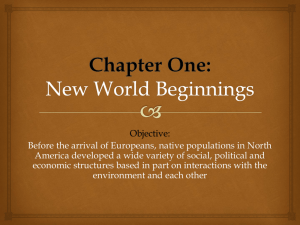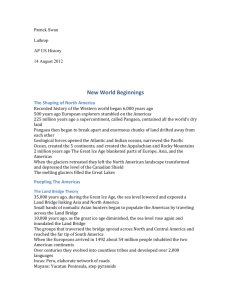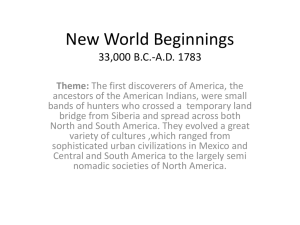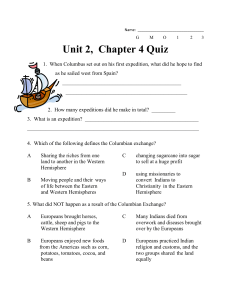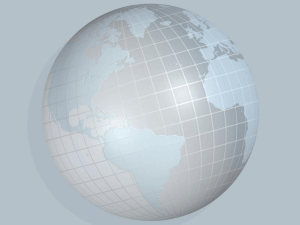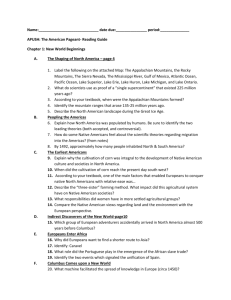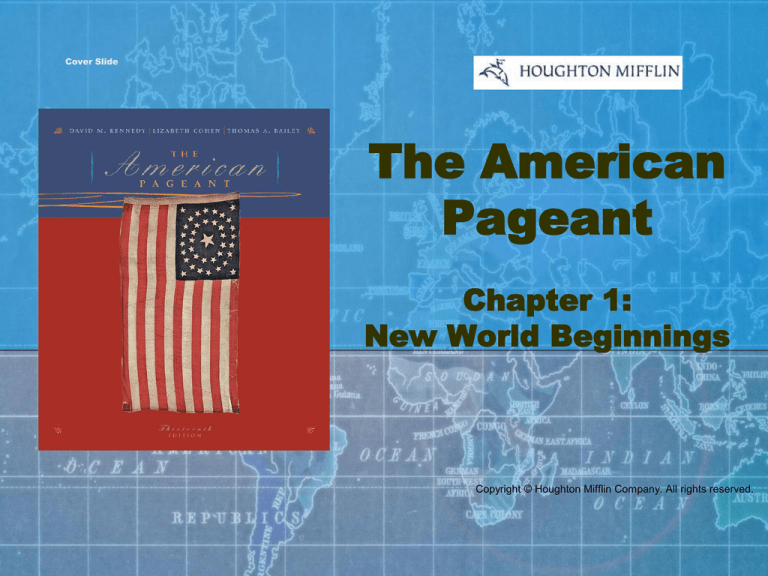
Cover Slide
The American
Pageant
Chapter 1:
New World Beginnings
Copyright © Houghton Mifflin Company. All rights reserved.
The Shaping of North America
• 6,000 years ago =
beginning of recorded
history
• 500 years ago =
Europeans set foot on the
Americas to begin
colonization
• Pangaea
• Theory suggesting that the
continents were once
nestled together into one
mega-continent
• They then spread out as
drifting islands.
The Shaping of North America
• Geologic forces of
continental plates
created the
Appalachian &
Rocky Mountains.
• The Great Ice Age
thrust down over
North America
• scoured the present
day American
Midwest.
Peopling the Americas
• Land Bridge theory
• Great Ice Age diminishes & glaciers melt
• Land Bridge emerges linking Asia & North
America
• across the Bering Sea
• People were said to have walked
across the "bridge" before the sea
level rose & sealed it off
• populating the Americas
• said to have occurred an estimated
35,000 years ago.
Map 1.1 The Ice Age and the Settling of the
Americas (p. 8)
• Some sixteen thousand
years ago, a sheet of
ice covered much of
Europe & North
America. Taking
advantage of a broad
bridge of land
connecting Siberia and
Alaska, hunting peoples
from Asia Migrated into
North America,
searching for large
game animals, such as
woolly mammoths and
ice-free habitats. By
10,000 B.C. the
descendants of the
migrant peoples had
moved as far south of
present-day Florida and
central Mexico.
Peopling the Americas
• Many peoples
• Those groups that traversed the bridge
spread across North, Central, and South
America.
• Countless tribes emerged with an
estimated 2,000 languages. Notably:
• Incas: Peru, with elaborate network of
roads and bridges linking their empire.
• Mayas: Yucatan Peninsula, with their
step pyramids.
• Aztecs: Mexico, with step pyramids and
huge sacrifices of conquered peoples.
Native American Worlds: Mayans
• Yucatan
Peninsula &
Guatemala
• Built large
religious
centers &
urban
communities.
• Stratified
society
• ~A.D. 800,
Mayan
civilization
declined
Native American Worlds: Aztecs
• A.D. 1325: Aztecs build
Tenochtitlán (Mexico
City)
• Established a
hierarchical social
order
• Subjugated most of
central Mexico
• By A.D. 1500,
• Tenochtitlán had
grown into a
metropolis of over
200,000 inhabitants
• the Aztecs were
unchallengeable
Gold Piece from Peru
(p. 9) Dumbarton Oaks
Research Library &
Collections, Washington,
DC.
• Skilled Inca artisans
created gold jewelry and
artifacts of striking
beauty. Found in a tomb,
this figurine may be a
stylized image of the dead
man, who was
undoubtedly a noble of
considerable status. Note
the intricate detail in the
man’s headdress and
garment.
The Earliest Americans
• Development of corn or maize around
5,000 B.C. in Mexico = revolutionary:
• people didn't have to be huntergatherers
• could settle down & be farmers.
• gave rise to towns & then cities.
• Corn arrived in the present day U.S.
around 1,200 B.C.
The Earliest Americans
• Pueblo Indians
• = 1st American corn growers
• lived in adobe houses (dried mud) &
pueblos
•= villages of cubicle shaped adobe
houses
•stacked one on top the other
•often beneath cliffs.
• had elaborate irrigation systems to
draw water away from rivers to
grown corn.
The Earliest Americans
• Mound Builders
• built huge ceremonial & burial mounds
• located in the Ohio Valley.
• Cahokia, near East St. Louis today = 40,000 people.
• Eastern Indians
• grew corn, beans, & squash in three sister farming:
• Corn grew in a stalk = a trellis for beans
• beans grew up the stalk
• squash's broad leaves kept the sun off the ground
• kept the moisture in the soil.
• had the best (most diverse) diet of all North
American Indians
• Included the Cherokee, Creek, Choctaw (South)
& Iroquois (North).
The Earliest Americans
• Iroquois Confederation
• Hiawatha = legendary leader
• The Iroquois Confederation = a group of 5
tribes in New York state.
• matrilineal
• authority & possessions passed down
through the female line.
• Each tribe kept their independence
• met occasionally to discuss matters of
common interest, like war/defense.
• not the norm
• Usually, Indians were scattered &
separated (and thus weak).
The Earliest Americans
• Native Americans different view of things as
compared to Europeans.
• felt no man owned the land, the tribe did.
• Europeans liked private property
• felt nature was mixed with many spirits
• Europeans = Christian & monotheistic
• felt nature was sacred
• Europeans felt nature & land was
given to man by God in Genesis to be
subdued & put to use
• had little or no concept or interest in money
• Europeans loved money or gold
Indirect Discoverers of the New World
• 1st Europeans to come to America = the Norse
(Vikings from Norway).
• Around 1000 AD, the Vikings landed
• led by Erik the Red & Leif Erikson.
• landed in Newfoundland or Vinland (because of
all the vines).
• left America & left no written record
• therefore didn't get the credit.
• only record is found in Viking sagas or songs.
• Christian Crusaders of Middle Ages fought in
Palestine to regain the Holy Land from Muslims.
• mixing of East & West created a sweet-tooth
• Europeans wanted the spices of the exotic East
Europeans Enter Africa
• Marco Polo traveled to China
• stirred up European interest
• an East to West (Asia to Europe)
trade flourished
•Desire for spices
•Route had to be overland, at least
in part.
• initiated new exploration down
around Africa in hopes of an easier
(all water) route.
Europeans Enter Africa
• Portugal started a sailing school
• Hopes to find better ways to get to the Spice
Islands
• eventually rounded Africa's southern Cape of
Good Hope.
• New developments:
• caravel:
• ship with triangular sail that could better
tack (zig-zag) ahead into the wind and thus
return to Europe from Africa coast.
• compass: to determine direction.
• astrolabe: device thatcould tell a ship's
latitude.
Europeans Enter Africa
• Slave trade begins
• 1st slave trade = across Sahara Desert
• Later, it was along the West African coast
• Slave traders purposely busted up tribes
& families in order to prevent any
possible uprising.
• Slaves wound up on sugar plantations
• Portuguese established them in the
tropical islands off Africa's coast.
• Spain watched Portugal's success with
exploration & slaving
• wanted a piece of the pie.
Columbus Comes upon a New World
• Christopher Columbus:
• convinced Isabella & Ferdinand to fund
his expedition (Spanish King/Queen)
• goal = to reach the East (East Indies) by
sailing west
• bypassing the around-Africa route that
Portugal monopolized.
• misjudged the size of the Earth though
• Thought it = 1/3 the size of what it was.
• After ~30 days at sea, struck land
• assumed he'd made it to the East Indies
• mistook the people as "Indians."
When Worlds Collide
• Economic system:
• Europe provides
•market, capital, technology.
• Africa provides
•the labor.
• The New World provides
•raw materials (gold, soil, lumber).
• Biological exchange:
• we traded life such as plants, foods,
animals, germs.
When Worlds Collide: Columbian Exchange
• From New World (America) to Old
• corn, potatoes, tobacco, beans, peppers,
manioc, pumpkin, squash, tomato, wild rice,
etc.
• also, syphilis
• From Old World to New
• cows, pigs, horses, wheat, sugar cane, apples,
cabbage, citrus, carrots, Kentucky bluegrass,
etc.
• devastating diseases (smallpox, yellow fever,
malaria)
• Indians had no immunities built up over
generations.
• estimated 90% of all pre-Columbus Indians
died, mostly due to disease.
Map 1.6
The
Columbian
Exchange
(p. 28)
As the European traders & adventurers traveled to Africa, the
Americas & Asia between 1430 & 1600, they began what
historian call the “Columbian Exchange,” a vast
intercontinental movement of the plants, animals, & diseases
that changed the course of historical development. As the
nutritious, high-yielding American crops of corn & potatoes
enriched the diets of Europeans & Africans, the Eurasian &
African disease of smallpox, diphtheria, malaria, & yellow
fever nearly wiped out the native inhabitants of the Western
Hemisphere & virtually ensured that they would lose control
of their lands.
The Spanish Conquistadores
• Treaty Line of Tordesillas 1494:
Portugal & Spain feuded over land.
• Pope drew this line
•he was respected by both
• line ran North-South,& chopped off
the Brazilian coast of South America
• Portugal got everything east of line
•Brazil & land around/under Africa
• Spain got everything west of the line
•= much more, though they didn't
know it at the time
Treaty of Torsedillas
The Spanish Conquistadores
• Conquistadores = "conquerors"•
• Vasco Balboa: "discovered"•the
Pacific Ocean across isthmus of
Panama
• Ferdinand Magellan:
circumnavigates the globe (1st to do
so)
• Ponce de Leon: touches & names
Florida looking for
legendary Fountain of Youth
The Spanish Conquistadores
• Hernando de Soto: enters Florida, travels
up into present day Southeastern U.S.,
dies & is "buried"•in Mississippi River
• Francisco Pizarro: conquers Incan Empire
of Peru & begins shipping tons of
gold/silver back to Spain.
• huge influx of precious metals made
European prices skyrocket (inflation)
• Francisco Coronado: ventured into
current Southwest U.S. looking for
legendary El Dorado, city of gold. He
found the Pueblo Indians.
Figure 1.2
The Great
Price
Inflation &
Living
Standards
in Europe
(p. 34)
As American gold & silver poured into Europe after 1520,
there was more money in circulation & people used it to
bid up the price of grain. Grain prices also rose because
of increasing demand; the result of growth in Europe’s
population. Because prices rose faster than wages living
standards fell from a high point about 1430 to a low
point about 1630. As “real wages” rose after 1630,
people lived better.
The Conquest of Mexico
• Hernando Cortez conquered the
Aztecs at Tenochtitlan.
• went from Cuba to present day Vera
Cruz, then marched over mountains
to the Aztec capital.
• Montezuma, Aztec king:
• thought Cortez might be the
god Quetzalcoatl who was due to reappear the very year
• welcomed Cortez into Tenochtitlan.
The Conquest of Mexico
• Montezcuma attacks Spanish:
• Spanish lust for gold leads to attack
• Night is called noche triste, sad night
• Cortez & men fought their way out,
• smallpox eventually beats the Indians.
• Spanish then destroyed Tenochtitlan
• Build the Spanish capital (Mexico City) on
top of the Aztec city.
• A new race of people emerged, mestizos
• = mix of Spanish & Indian blood.
The Spread of Spanish America
• Spanish society quickly spread through
Peru & Mexico
• threats came from neighbors:
• English:
• John Cabot (an Italian who sailed for
England) touched the coast of the
current day U.S.
• France:
• Giovanni de Verrazano touched on the
North American seaboard.
• Jacques Cartier went into mouth of St.
Lawrence River (Canada).
The Spread of Spanish America
• To protect lands:
• Spain set up forts (presidios) all over the
California coast
• Also cities, like St. Augustine in Florida.
• Don Juan de Onate
• followed Coronado's path into present day
New Mexico
• conquered the Indians ruthlessly,
• Maimed them by cutting off one foot of
survivors just so they'd remember.
• Despite mission efforts
• Pueblo Indians revolted in Pope's
Rebellion.
The Spread of Spanish America
• Robert de LaSalle
• sailed down the Mississippi
River for France
• claiming the whole region for their King
Louis
• naming the area "Louisiana" after his king
• started a slew of place-names for that
area
• LaSalle, Illinois to "Louisville"•
• New Orleans (the American counter of
Joan of Arc's famous victory at
Orleans).
The Spread of Spanish America
• Black Legend:
• the notion that Spaniards only
brought bad things (murder, disease,
slavery)
• true
• BUT they also brought good things:
•law systems, architecture,
Christianity, language, civilization,
• Black Legend is partly, but not
entirely, accurate.

